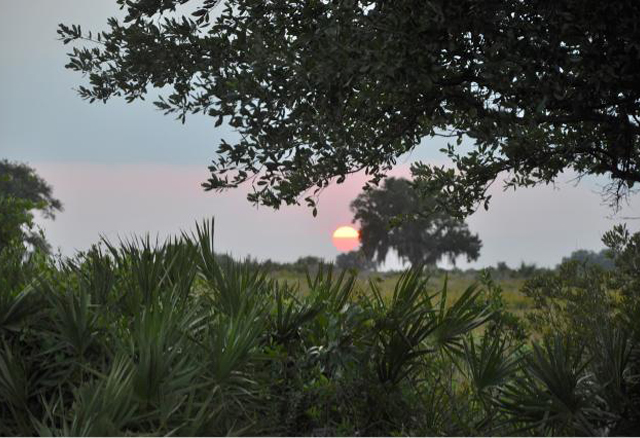Aligning Security, Climate Change & Conservation
On May 10, 2013, a grim milestone occurred as scientists at Hawaii’s Mauna Loa Observatory announced an average daily atmospheric carbon dioxide reading just above 400 parts per million, thus confirming Earth’s entry into a new era of climate change and its related risks. This reading, the highest recorded in more than three million years, serves as a clarion call for the need to adapt to a “new normal,” which already includes severe and destructive weather events, drought and flooding. Moreover, it will include dramatically rising seas with floods of epic proportions, displaced populations and unpredictable – and undependable – quantities of clean, fresh water.
For wildlife and habitat, a rapidly changing climate represents a system shock requiring a radical rethinking of older models that previously and justifiably included static protected areas with well-defined boundaries. This means new, adaptive strategies must be applied, which anticipate migration of habitat and species northward, inland and to higher elevations. Furthermore, conservation and restoration of natural “infrastructure” must be accorded greater weight in national and local planning because of their recognized values both in mitigating climate change’s multiple impacts and in sequestering carbon.
The US Fish and Wildlife Service (FWS), in its role as a key agency operating on the frontlines of this challenge, has often brought together unlikely partners to address anticipated changes and to achieve its sweeping wildlife conservation mission. An anchor for these activities is the 150-million-acre National Wildlife Refuge (NWR) System, the world’s largest single conservation program. Despite this distinction, FWS understands this assemblage of protected areas sometimes is not ecologically sufficient to fulfill its lofty mission and has, therefore, welcomed partnerships with other agencies and private landowners to maximize its wildlife conservation impact. This is particularly true in light of changes to habitat as a result of climate change. These partnerships provide for migration corridors, additional habitat for species conservation and recovery, and nodes for species refugia to offset advancing urbanization.
One such example is FWS’s established and growing collaboration with the Department of Defense (DoD), itself a steward of 25 million acres of land with a large portion wildlife refuge quality. The military, similar to many wildlife species it protects, requires significant, contiguous areas with minimal residential, commercial or industrial presence for training and testing purposes.
Despite success in partnering at the military installation level, FWS’ focus on landscape-scale conservation coupled with climate change habitat impacts raises the question: What are the game-changing next steps in the DoD-FWS partnership? This partnership, originally conceived to protect important habitat and species while simultaneously sustaining military missions, encourages compatible land use that helps protect Defense bases from encroachment. Can it now evolve to meet both organizations’ respective needs to address risks of climate change?
Partnering for Wildlife & National Security
The original Sikes Act in 1960 recognized the importance and value of military lands to natural resources. Since then, the win-win FWS-DoD relationship has evolved to embrace transfers of former military bases for conservation purposes as well as implementation of complex landscape-scale partnerships involving active military bases.
“It amazes me today what great synergies we get from each other. Where we have wildlife refuges that buffer military installations, everybody wins,” says recently retired Major General James A. Kessler, former Commander, Marine Corps Installations Command/Assistant Deputy Commandant for Installations and Logistics. “Our objectives may be different, but the end state is the same. That’s what makes the partnership so healthy.”
At present, many partnerships focus on the immediate overlay of the military mission footprint with nearby refuges. This opportunity is possible because 250 of 561 wildlife refuges nationwide are located within 20 miles of a military installation. That dynamic is now starting to change in ways that widen the landscape and broaden opportunities for both parties. FWS Director Dan Ashe sums up the opportunity for landscape-scale conservation as follows: “There’s rarely going to be enough decision space left at a single installation to do what DoD and FWS both need to meet their respective requirements. But, together we can blow that out, expand it beyond the boundaries of installations and refuges, and make a commitment to do that for the future.”
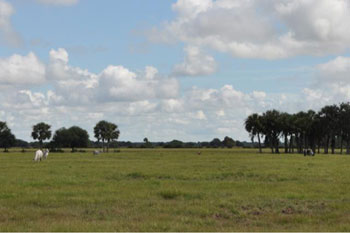
Photo Courtesy: Evan Hirsche | In 2012, FWS announced the Everglades Headwaters NWR to address needs like conserving wildlife habitat and providing a military buffer.
Paul Friday, Acting Assistant Chief of Staff in G-7 at Marine Corps Installations East, agrees with this basic premise: “Larger landscape scales present expanded opportunities for mission, compatible land use and conservation attributes.” An exemplar of such expanded partnerships can be found at South Central Florida’s Avon Park Air Force Range and includes the US Air Force (USAF), FWS, National Wildlife Refuge Association (NWRA), The Nature Conservancy (TNC) and local ranching community. These organizations, which own large swaths of land, are working together to protect military airspace and range boundary requirements, to help maintain a rural way of life for landowners and to address a top FWS conservation priority by expanding its recently established Everglades Headwater NWR. Located at the northernmost portion of the Everglades, this mosaic of public and private lands comprises some 150,000 acres of scrub, ranchland and oak savannah, representing a vital future stronghold for the endangered Florida panther as projected sea level rise inundates South Florida in the coming centuries.
In eastern North Carolina, the Air Force’s and Navy’s 46,000-acre Dare County Bombing Range is surrounded by FWS’s 152,000-acre Alligator River NWR, which helps provide a buffer against encroachment and also “acts like a weapons safety buffer zone” in the words of Fred Pease, USAF Deputy Assistant Secretary of Environment, Safety and Occupational Health and former DoD liaison in the office of the Secretary of Interior. FWS also benefits as the refuge’s flagship species, the wide-ranging endangered red wolf and other wildlife, depend on the contiguous habitat synergy between the Range and NWR. And yet, ditching on the land, which predates the refuge and Range, has created dual threats of peat fires and saltwater incursion stemming from sea level rise. The condition came to a head two years ago when the Pain’s Bay fire burned for three months, required $16 million to extinguish and created smoke that rendered the Range inoperable for many days.
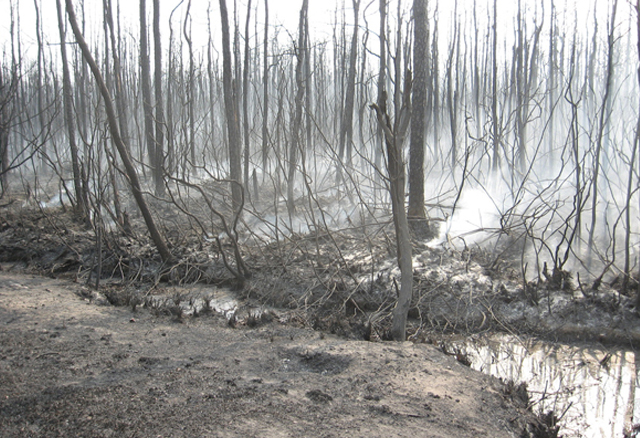
Photo Courtesy: USFWS/Rob Wood | Historical drainage canals led to the burning of 45,294 acres within three months while interrupting military training activities.
In response to this threat, DoD, FWS and TNC have partnered to establish a water-management system that will re-saturate the peat woodlands, reduce risks of fire and smoke, restore fresh water habitat, which will benefit wildlife, and slow effects of rising seas. “This partnership gives the Range maximum operational capacity while slowing climate change effects and creating more habitat for wildlife. It’s a win all the way around,” says Mike Bryant, Alligator River Refuge manager.
Partnering to Address Climate Change
These mutually beneficial activities have the potential to serve as an underpinning for a climate change adaptation and mitigation partnership that is a natural extension of the relationship. Former Deputy Undersecretary of Defense for Environmental Security Sherri Goodman, now senior vice president and general counsel for CNA Corporation, introduced many of DoD’s environmental security initiatives in the 1990s. She points out that issues once cast solely as environmental have now converged with classical homeland security issues: “We have all been talking about environment as a national security factor for the past 20 years, but it’s only recently that we are now seeing a closer coupling between environmental issues and those we would classify as homeland security issues – problems stemming from climate-related events.”
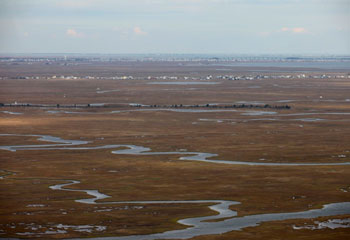
Photo Courtesy: USFWS/Greg Thompson | Edwin B. Forsythe NWR’s tidal marshes were near the epicenter of Hurricane Sandy and provided crucial flood protection.
From the standpoint of climate change and sea level rise, the Refuge System offers a natural ability to buffer inland and shoreline areas, including military installations, from storm surge and sea level rise. Beyond the immediate mission protection aspects provided by refuges, they also provide DoD with numerous ecosystem service benefits that directly or indirectly support military installation operation. Conserving and expanding such ecosystem benefits support the military services’ ability to meet requirements to develop climate adaptation strategies. These benefits include watershed protection, stormwater runoff management, storm surge protection, aquifer recharge and enhancement of water supplies. Indeed, the Refuge System provides approximately $26.9 billion in ecosystem services per year for the lower 48 states alone, and DoD benefits from this important function. That value may grow in some locations as wetlands and “natural infrastructure” provided by national wildlife refuges absorb or reduce damage resulting from climate induced sea level rise and severe droughts and flooding.
Rapidly changing climate demands development of new and comprehensive strategies that anticipate changing habitats and altered migratory behaviors. “Changing climate and water regimes, temperature fluctuations, wildfires and other considerations mean habitat is changing and species are moving. In this context, large landscapes without barriers become very important to habitat while at the same time providing important protections for the military mission, including maneuver room, encroachment prevention and weapon-system safety zones,” explains David Houghton, NWRA president and a leading advocate for the FWS and Refuge System.
Ideas for a Path Forward
Ultimately, a rapidly changing climate regime sets in motion perpetual uncertainty that calls for creating new strategies to recreate a resilient future. While DoD-FWS partnerships have demonstrated their intrinsic value for habitat enhancement and preservation of military service training, testing and operations missions, they have not as yet undertaken a systematic look at how to jointly address risks of climate change. As Houghton says: “DoD and FWS are both looking at climate change; they’re just not looking at it together.”
Congress and DoD have shown an ability in the past to take lessons learned and to remove impediments from achieving the full potential of DoD-conservator partnerships. For example, a statute that allowed DoD to partner with states, their political subdivisions and private environmental groups to achieve mission-protecting conservation buffers was amended to allow DoD partnerships on “like ecological parcels” not contiguous to installations or ranges – an amendment that enhanced DoD’s ability to engage on landscape or ecosystem partnerships with FWS and other entities. Perhaps now is the time for Congress, DoD and FWS to look at other initiatives that could advance common agendas through the conservation fulcrum.
One promising opportunity is to strengthen DoD’s Readiness and Environmental Protection Integration (REPI) program by explicitly including climate resilience and other ecological services criteria as evaluation factors. REPI already “promotes innovative land conservation solutions that benefit military readiness, neighboring communities and the environment.” As it now stands, REPI-funded partnerships may have the effect of addressing some climate issues, but they are not scored on that basis or for that purpose. Because the REPI program is aimed at enhancing DoD mission readiness, and since DoD is already positioning military services to address climate change impacts and their attendant risks to mission, such a change to REPI program evaluation criteria could be considered a logical next step in any future DoD-FWS agenda.
A related possibility would be to evaluate REPI funding levels. Preserving training capability should be fundamental to each military service. Yet, with the exception of a large spike in 2011, REPI funding has been plus or minus $55 million since FY 2009, approximately 1/100th of one percent of the FY13 DoD budget. Many in the Pentagon would consider this little more than “decimal dust.” Given the leverage and benefits inherent in the REPI program, coupled with the fact that, if left unaddressed, further encroachment against DoD air and land training resources is inevitable, this funding falls short of that needed for protecting future training and resource management requirements. DoD spends approximately $25 billion per year on research, development, testing and evaluation – all for good reason – but only spends about one-fourth of one percent of that amount to protect its training capability for future weapon systems and force structure.
Another opportunity could be in expanding the DoD-FWS partnership to look at the network of lands that lie beneath military training routes (MTR) and Special Use Airspace (SUA). An idea being explored by the Marine Corps’ Paul Friday, this could help to preserve low-level flying routes for training by providing critically important over-flight areas free of land-based impediments to aircraft. This option could also offer opportunities to connect wildlife refuges; to create habitat corridors, which would promote species health and, in some cases, sequester carbon dioxide; and to establish larger climate buffers against effects of violent weather. In the US Southeast alone, an estimated minimum of six million acres of additional land below MTRs and SUAs could still be secured in ways that are mission enhancing, landscape compatible and habitat preserving – and that could help lead to climate change adaptation and/or mitigation.
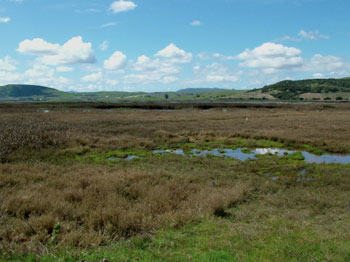
Photo Courtesy: USFWS | Beneficial Reuse: A Naval Station since 1941, California’s Skaggs Island was restored and transferred to FWS in 2011.
Others such as former Deputy Assistant Secretary of the Interior Lynn Scarlett, now managing partner for public policy at The Nature Conservancy, suggest that DoD-FWS partnerships need not always be aimed at land acquisition per se. Scarlett points to the value in restoring hydrologic and other ecological functions of lands within and beyond boundaries of the Refuge System that provide benefits to DoD, such as protection of its watersheds and enhancement of its water supplies. She suggests FWS and DoD identify “conservation law enforcement, monitoring and other financial and technological tools” that would allow DoD to assist FWS with both habitat restoration and adaptive management on non-DoD lands. “The more habitat is restored,” Scarlett points out, “the more is available to generate benefits for DoD lands.”
In a similar vein, FWS Landscape Conservation Cooperatives could be helpful. These multi-partner conservation collaboratives provide the science and technical expertise needed to support conservation planning at landscape scales. They could look at enhancing their data collection activities by more explicitly integrating data and other information collected from DoD sites, many of which are located proximate to areas where FWS is collecting data.
Bottom Lines
Given enhancements to DoD’s readiness provided by the Refuge System’s protection of military training and testing capabilities, as well as climate security and other ecological services benefits provided by refuges, the business case for further DoD investment in the FWS partnership should be apparent to policy makers and Congressional leaders alike.
The urgency to consider such enhanced investments in conservation strategies that protect DoD’s mission should become even clearer when one considers potential national security implications from climate change risk. The ability of the Refuge System and a broader conservation mosaic – achieved through REPI and similar partnerships – to mitigate and help adapt to those risks is obvious. Unfortunately, many think the threat of climate change effects for DoD are 60 to 100 years away. While that may be true for some climate change impacts, numerous significant, short-term effects are already evident, such as more destructive and frequent weather events, eroding and inward moving coastlines, threatened water supplies and biodiversity losses and migrations.
The risk of waiting to act is that once such climate-induced encroachment occurs on DoD installations – either by population growth, species migration, increased wildfires or other destructive events, coastal erosion or sea level rise, to name a few – training and operating capability is degraded. And, the likelihood that it can be mitigated is minimal unless substantial funding can be found for other alternatives. DoD often utilizes a 20-year or more planning horizon for warfighting capability and, even though it is in an era of constrained resources, DoD would be shortsighted not to consider and safeguard long-term training and operating resources, particularly when doing so would involve a comparatively modest additional investment.
Mamie Parker, PhD and former FWS Assistant Director of Fisheries, Habitat and Conservation, describes what is at stake for both agencies in this way: “The Fish and Wildlife Service is all about protecting air, land and water, just as the military needs those same assets to train and operate. Climate change and risk are where issues of the future will really eat up the time and financial resources of both organizations. I’m hoping it’s not too late and that we can put our heads together and work towards collaborative solutions.”

